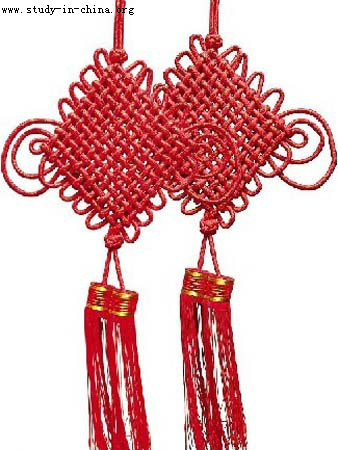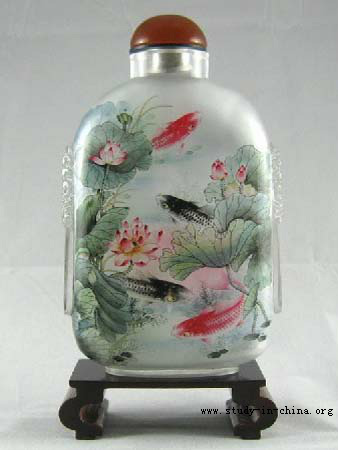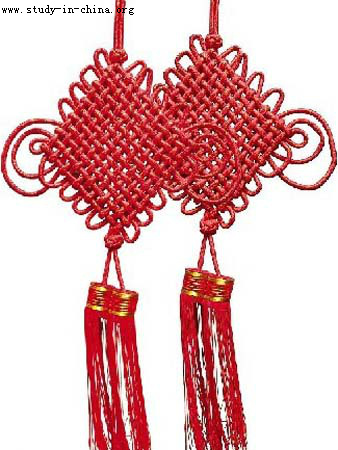Top 7 Traditional Chinese Gifts for Christmas

7.Chinese knotting
Chinese knotting is a decorative handicraft art that began as a form of Chinese folk art in the Tang and Song Dynasty (960-1279 AD) in China. It was later popularized in the Ming. The art is also referred to as Chinese traditional decorative knots. In other cultures, it is known as "Decorative knots".
Chinese knots are usually lanyard type arrangements where 2 cords enter from the top of the knot and 2 cords leave from the bottom. The knots are usually double-layered and symmetrical.

6.Chopsticks
Chopsticks originated in ancient China as early as the Shang dynasty (1766-1122 BCE). The earliest evidence of a pair of chopsticks, which was made out of bronze, was excavated from the Ruins of Yin near Anyang, Henan, dated roughly 1200 BCE. The earliest known extant textual reference to the use of chopsticks comes from the Han Feizi, a philosophical text written by Han Fei (c. 280-233 BCE) in the 3rd century BCE.
While China had long included chopsticks as part of their traditional eating utensils, the use of chopsticks in a limited sense spread to other Asian countries in recent centuries with the influx of Chinese immigrants in Southeast Asia.

5.Chinese tea
According to popular legend, tea was discovered by Chinese Emperor Shennong in 2737 BCE when a leaf from a Camellia sinensis tree fell into water the emperor was boiling.
Chinese tea can be classified into five distinctive categories, white, green, oolong, black/red and post-fermented. Others add categories for red, scented and compressed teas. All of these come from varieties of the Camellia sinensis plant. Green tea is the most popular type of tea consumed in China.
The Ten Great Chinese Teas are Dragon Well, Dongding Green Spiral, Anxi Iron Goddess, Yellow mountain Tip, Wuyi Rock Tea (Red Robe), Jun Mountain Silver Needle, Keemun Black Tea, Liuan Leaf, Yunnan Puer and White Tip Silver Needle.

4.Chinese embroidery
Chinese embroidery has a long history since Neolithic age. Because of the quality of silk fiber, most Chinese fine embroideries are made in silk.Chinese embroidery refers to embroidery created by any of the cultures located in the area that makes up modern China. It is some of the oldest extant needlework.
The four major regional styles of Chinese embroidery are Suzhou embroidery (Su Xiu), Hunan embroidery (Xiang Xiu), Guangdong embroidery (Yue Xiu) and Sichuan embroidery (Shu Xiu). All of them are nominated as Chinese Intangible Cultural Heritage.

3.Chinese painting
Chinese painting is one of the oldest continuous artistic traditions in the world. The earliest paintings were not representational but ornamental; they consisted of patterns or designs rather than pictures. It was only during the Warring States Period (475-221 BC) that artists began to represent the world around them.
The two main techniques in Chinese painting are meticulous and freehand.

2.Xun
The xun is a globular, flute-like, Chinese musical instrument. It is made of clay or ceramic, similar to an ocarina but without a fipple mouthpiece. Other Chinese flute-like instruments, such as the Wudu and Taodi, however, include a fipple.
The xun is made in several egg-shaped sizes, and is one of the oldest Chinese instruments. It has a blowing hole on top and generally eight smaller finger holes (three each for the index, middle, and ring fingers of each hand, and one for each thumb).

1.Snuff bottle
Snuff bottles were used by the Chinese during the Qing Dynasty to contain powdered tobacco. Smoking tobacco was illegal during the Dynasty, but the use of snuff was allowed because the Chinese considered snuff to be a remedy for common illnesses.
One of the most famous and collectible types of snuff bottles is the inside or reverse painted. These little masterpieces are painted by reaching down through the neck of the bottle with a tiny curved brush or piece of bamboo.
Chinese snuff bottles were typically decorated with paintings or carvings, which distinguished bottles of different quality and value. Decorative bottles were, and remain, time-consuming in their production and are thus desirable for today's collectors.
News&Opinion
 more
more- DR Congo, China Sign 16 mln USD Economic Agreeme...
- Asian Tour Hits Top Marks in 2011 Season
- Four Chinese Researchers Awarded "Green Talents"...
- Bank of China Opens New Branch in Kobe, Japan
- China's Cultural Security Lies in Openness and E...
- Hu Urges Joint Efforts to Promote Growth, Financ...
- China Launch Shenzhou-8 Successfully
- Attention! Halloween is Coming!
Policy&Laws
China Tops Bricks Table for UK Tourists: Report
LONDON - China is the most popular destination out of the BRICS amon...
Pupils Play with Pumpkins ahead of Halloween in ...
Pupils play with pumpkins during an activity for pupils in San Fra...
China Creates 9.94 Mln New Jobs by End of Sept.
China created 9.94 million new jobs by the end of September, exceedi...





 print
print  email
email  Favorite
Favorite  Transtlate
Transtlate 







